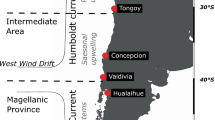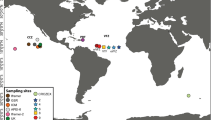Abstract
Since 1985, the nonindigenous polychaete species Marenzelleria neglecta has been found in the Baltic Sea. The species, which was introduced by ship ballast water, spreads rapidly and dominates in many habitats today. Using three gene segments of the mitochondrial DNA (16S rDNA, Cytochrom oxidase I, Cytochrom b), we investigated four populations of the western and northern Baltic Sea in a preliminary survey and compared them with four other populations from the North Sea, the Baltic Sea and from the Arctic. First, we could demonstrate the applicability of the markers to discriminate the species with certainty. Second, with M. viridis and M. arctia, we could detect two more species of the same genus, which have recently been introduced into the Baltic Sea. One of these, M. arctia, was hitherto known as an exclusive arctic member of the genus. The impact of these two recently invaded Marenzelleria species onto the autochthonous fauna needs to be evaluated in the future. The Baltic Sea as a ‘natural aquarium’ now offers the possibility to investigate sibling species simultaneously. However, correct identification and denomination of Marenzelleria species are indispensable prerequisites for all future studies. Molecular markers allow the exact identification of all Marenzelleria species and must be used whenever a classical taxonomic identification is uncertain.
Similar content being viewed by others
References
Bastrop R, Jürss K and Sturmbauer C (1998). Cryptic species in a marine polychaete and their independent introduction from North America to Europe. Molecular Biology and Evolution 15: 97–103
Bastrop R, Röhner M and Jürss K (1995). Are there two species of the polychaete genus Marenzelleria in Europe?. Marine Biology 121: 509–516
Bastrop R, Röhner M, Sturmbauer C and Jürss K (1997). Where did Marenzelleria spp. (Polychaeta: Spionidae) in Europe come from?. Aquatic Ecology 31: 119–136
Blank M, Bastrop R, Röhner M and Jürss K (2004). Effect of salinity on spatial distribution and cell volume regulation in two sibling species of Marenzelleria (Polychaeta: Spionidae). Marine Ecology Progress Series 271: 193–205
Bick A (2005). A new Spionidae (Polychaeta) from North Carolina and a redescription of Marenzelleria wireni Augener, 1913, from Spitsbergen, with a key for all species of Marenzelleria. Helgoland Marine Research 59: 265–272
Bick A and Burckhardt R (1989). First record of Marenzelleria viridis (Polychaeta, Spionidae) in the Baltic Sea, with a key to the Spionidae of the Baltic Sea. Mitteilungen des Zoologischen Museums Berlin 65: 237–247
Boore JL and Brown WM (2000). Mitochondrial genomes of Galathealinum, Helobdella and Platynereis: sequence and gene arrangement comparisons indicate that Pogonophora is not a phylum and Annelida and Arthropoda are not sister taxa. Molecular Biology and Evolution 17: 87–106
Carlton JT and Geller JB (1993). Ecological Roulette: the global transport of nonindigenous marine organisms. Science 261: 78–82
Dermott R and Kerec D (1997). Changes to the deepwater benthos of eastern Lake Erie since the invasion of Dreissena: 1979–1993. Canadian Journal of Fisheries and Aquatic Sciences 54: 922–930
Elliott M and Kingston PF (1987). The sublittoral benthic fauna of the estuary and Firth of Forth, Scotland. Proceedings of the Royal Society of Edinburgh 93B: 449–465
Essink K and Kleef HL (1993). Distribution and life cycle of the North American spionid Marenzelleria viridis (Verrill, 1873) in the Ems estuary. Netherland Journal of Aquatic Ecology 27: 237–246
Folmer O, Black MB, Hoch W, Lutz RA and Vrijehock RC (1994). DNA primers for amplification of mitochondrial cytochrome c oxidase subunit I from diverse metazoan invertebrates. Molecular Marine Biology and Biotechnology 3: 294–299
Hall TA (1999). Bioedit: A user-friendly biological sequence alignment editor and analysis program for Windows 95/98/NT. Nucleic Acids Symposium Series 41: 95–98
Kessing B, Croom H, Martin A, McIntosh C and Owen McMillan W (1989). The Simple Fool’s Guide to PCR. University of Hawaii, Honolulu
Pimentel D, Lach L, Zuniga R and Morrison D (2000). Environmental and economic costs of nonindigenous species in the United States. BioScience 50: 53–65
Röhner M, Bastrop R and Jürss K (1996a). Genetic differences between two allopatric populations (or sibling species?) of the polychaete genus Marenzelleria in Europe. Comparative Biochemistry and Physiology 114B: 185–192
Röhner M, Bastrop R and Jürss K (1996b). Colonization of Europe by two American genetic types or species of the genus Marenzelleria (Polychaeta: Spionidae). An electrophoretic analysis of allozymes. Marine Biology 127: 277–287
Sikorski AV and Bick A (2004). Revision of Marenzelleria Mesnil, 1896 (Spionidae, Polychaeta). Sarsia 89: 253–275
Spidle AP, Marsden JE and May B (1994). Identification of the Great Lakes quagga mussel as Dreissena bugensis from the Dnieper River, Ukraine, on the basis of allozyme variation. Canadian Journal of Fisheries and Aquatic Sciences 51: 1485–1489
Author information
Authors and Affiliations
Corresponding author
Rights and permissions
About this article
Cite this article
Bastrop, R., Blank, M. Multiple Invasions – A Polychaete Genus Enters the Baltic Sea. Biol Invasions 8, 1195–1200 (2006). https://doi.org/10.1007/s10530-005-6186-6
Received:
Accepted:
Published:
Issue Date:
DOI: https://doi.org/10.1007/s10530-005-6186-6




